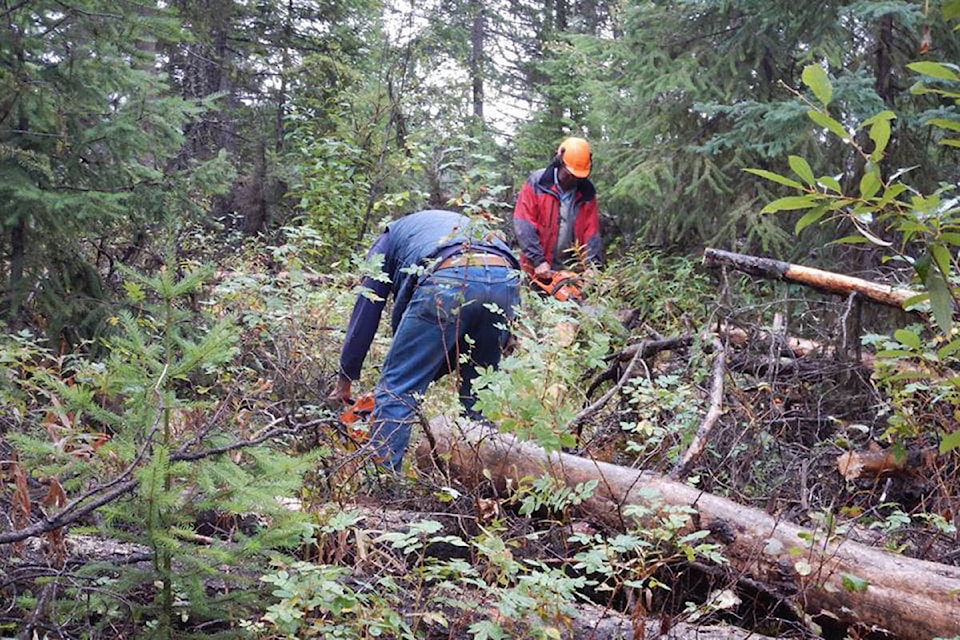The local chapter of the B.C. Back Country Horsemen plans to rebuild part of the Collin’s Overland Telegraph Trail.
The section of trail being rebuilt spans 65 kilometres from the trailhead on Rawlings Road to Blackwater River.
Rob LaFrance, the chair of the North Cariboo chapter of the Back Country Horsemen, is leading the efforts to rebuild the trail. He wants to create a place where horsemen (and women) and hikers alike can explore the back country around Quesnel. In the middle of the trail, he even wants to set up a horse-friendly campground.
When LaFrance moved to Quesnel from the coast, he found that the trails in the Quesnel area were not as well groomed and had less water access than they do at the coast. “And I love going through rivers,” LaFrance says.
Then he met Dwight Dodge, a man who had been working to preserve the Telegraph Trail since 1953.
A brief history of the trail
The Back Country Horsemen had historian Kelley Cook draw up a report on the Telegraph Trail to help make the provincial government more amenable to their efforts on the trail.
The Telegraph Trail was originally designed in the early 1860s in an effort to create a telegraph line that ran from California through B.C. and the Yukon into Alaska and across the Bering Strait to Russia. The goal was to create the first telegraph line between North America and Europe.
But it was never completed. Cyrus Field’s Atlantic underwater telegraph cable beat them to the punch, and the trail was abandoned in the spring of 1867.
According to Cook’s report, the telegraph line only continued to be active as far north as Quesnel, but the trail was used as an overland route to the Klondike, Cassiar and Omineca gold rushes
In 1901, the section of the trail near Quesnel became part of the Quesnel to Atlin Telegraph Line.
The line was in use until 1936, when floods took out much of the line. They didn’t bother to rebuild it, as by this point, technology had developed and the use of wireless radios for communication was growing more and more common.
Man on a mission
Dwight Dodge worked on the Telegraph Trail from 1953 until his death in 2016. He ran the Telegraph Trail Preservation Society in Quesnel, which disbanded in 2006, and continued to work on the trail even afterwards.
“From what I’ve read,” says LaFrance, “he fell in love with [the trail] when he was younger and he ended up buying property that was right on it.” Dodge lived there, at the trailhead, for the rest of his life.
Shortly after LaFrance moved to the area, he met Dodge and began to work with him on the trail.
Following his death, LaFrance says Dodge had intended to donate the land to the Cariboo Regional District so that the trailhead could continue to be used. Unfortunately, LaFrance says, the CRD did not move quickly enough and Dodge died before arrangements could be made.
In his honour, LaFrance designed Dwight’s Loop, an approximately 15 km trail that connects with the Telegraph trail before it loops around. “It’s been getting quite popular. We get a lot of hikers on it too, not just horse people, which is nice.”
Unable to buy the portion of Dodge’s old property with the trailhead, the Back Country Horsemen are now waiting for permission to build a new trailhead in a different spot.
Trail plans
But even without the original trailhead, the Horsemen have big goals for the trail. The original trail has been taken over by the river in many places, says LaFrance. They’re hoping the new trail can follow just 50 metres off the road.
They’re also planning to clean up the old telegraph wire. After surviving, in some cases, more than 100 years on the trail, the wood used to hold it up has decayed, leading to sagging wires animals can sometimes get tangled in, which ultimately proves fatal.
Just last February, a Squamish-based veterinarian created a petition calling on the federal government to remove all the leftover telegraph wire in Canada, after her husband stumbled on the carcasses of three moose tangled in a one-kilometre stretch of wire.
Each kilometre that the Horsemen maintain of the old trail costs them approximately $1,000, while every kilometre they rebuild costs approximately $2,000.
The group has managed to raise $52,173.55 through grants and donations they’ve received from organizations and businesses in the area.
The largest of these is a $30,000 grant from the Northern Development Initiative Trust, which LaFrance intends to use to hire a crew to extend the trail 35 kilometres from Goose Lake to Blackwater River. The other 30 kilometres will be done by the volunteers.
“It’s beyond our scope,” says LaFrance, “that’s why we got the grant.”
The Horsemen and other volunteers start work on the trail for the season on July 7. They hope to complete the 65 km stretch by November.
heather.norman@quesnelobserver.com
Like us on Facebook and follow us on Twitter
